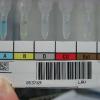Reputation Activity
-
 Dansket got a reaction from Ensis01 in Daily QC for ABO Reagents
Dansket got a reaction from Ensis01 in Daily QC for ABO Reagents
How many reagent racks do you QC daily? I wouldn't QC A2 cells daily unless I used them routinely for ABO grouping? There may be other reagents that you QC daily that aren't used daily.
-
 Dansket got a reaction from Ensis01 in Daily QC (again)
Dansket got a reaction from Ensis01 in Daily QC (again)
By definition, reagent reverse grouping A1 and B cells are used to detect anti-A and anti-B antibody in patient plasma. Accordingly A1 cells should react with anti-A but not with anti-B, and B cells should react with anti-B but react with anti-A. Therefore, A1 cells should not be agglutinated by anti-B. No agglutination is a negative test result, i.e., a negative control test. Likewise, B cells should not be agglutinated by anti-A. No agglutination is a negative test result, i.e. a negative control test.
Testing A1and B cells with AB plasma, Diluent, Albumin or saline may demonstrate that the test cells are not spontaneously agglutinating in their presence which serves as a negative control for those reagents, but does not serve as a negative control test for A1 cells or B cells.
-
 Dansket got a reaction from Malcolm Needs in Daily QC (again)
Dansket got a reaction from Malcolm Needs in Daily QC (again)
By definition, reagent reverse grouping A1 and B cells are used to detect anti-A and anti-B antibody in patient plasma. Accordingly A1 cells should react with anti-A but not with anti-B, and B cells should react with anti-B but react with anti-A. Therefore, A1 cells should not be agglutinated by anti-B. No agglutination is a negative test result, i.e., a negative control test. Likewise, B cells should not be agglutinated by anti-A. No agglutination is a negative test result, i.e. a negative control test.
Testing A1and B cells with AB plasma, Diluent, Albumin or saline may demonstrate that the test cells are not spontaneously agglutinating in their presence which serves as a negative control for those reagents, but does not serve as a negative control test for A1 cells or B cells.
-
 Dansket got a reaction from jojo808 in Daily QC (again)
Dansket got a reaction from jojo808 in Daily QC (again)
By definition, reagent reverse grouping A1 and B cells are used to detect anti-A and anti-B antibody in patient plasma. Accordingly A1 cells should react with anti-A but not with anti-B, and B cells should react with anti-B but react with anti-A. Therefore, A1 cells should not be agglutinated by anti-B. No agglutination is a negative test result, i.e., a negative control test. Likewise, B cells should not be agglutinated by anti-A. No agglutination is a negative test result, i.e. a negative control test.
Testing A1and B cells with AB plasma, Diluent, Albumin or saline may demonstrate that the test cells are not spontaneously agglutinating in their presence which serves as a negative control for those reagents, but does not serve as a negative control test for A1 cells or B cells.
-
 Dansket reacted to Malcolm Needs in Daily QC (again)
Dansket reacted to Malcolm Needs in Daily QC (again)
Anti-A for the group B red cells and anti-B for the A1 red cells.
-
 Dansket reacted to Patty in RHD Molecular Testing
Dansket reacted to Patty in RHD Molecular Testing
Just curious to know how many labs interpret a Bioclone Anti-D tube reaction of 1+ as Rh Neg. The insert does state any agglutination is considered a positive result for D antigen.
-
 Dansket got a reaction from jojo808 in inconclusive antibody ID
Dansket got a reaction from jojo808 in inconclusive antibody ID
JoJo808,
Which test method is used for routine testing at your facility? Were the "suspicious results" only observable by microscope? Were the night tech's "suspicious test results" reproducible?
Based on my routine testing protocol and detailed protocols for investigating "positive" antibody screens (that includes criteria for referring samples to a reference laboratory), I would not flag a patient with a history of "inconclusive antibody identification" for antiglobulin-crossmatching-in-perpetuity when subsequent antibody screens are negative.
It all depends on how well you feel your test system performs. If I didn't have a tightly controlled system, I might choose to require routine antiglobulin crossmatches in perpetuity for patients with a single positive antibody screen attributed to an "inconclusive antibody identification".
-
 Dansket reacted to AMcCord in Confirmatory test for ABO groups in first attend patients
Dansket reacted to AMcCord in Confirmatory test for ABO groups in first attend patients
Our experience w/ bedside testing for glucose at bedside and for stool occult blood card tests by nursing staff demonstrates that they don't understand QC, don't understand that if things don't look right you don't report it, don't document what they should document, etc. The thought of letting them perform confirmatory blood types for transfusion therefore scares the living daylights out of me. You can train some to perform the steps reliably, but without the lab background, I don't think you can expect good performance in dealing with unexpected results and test system problems (QC failure, weak/missing reactions, discrepant results). Those are the things that can result in a hemolytic transfusion reaction.
-
 Dansket got a reaction from Malcolm Needs in RHD Molecular Testing
Dansket got a reaction from Malcolm Needs in RHD Molecular Testing
To amaze you and challenge your statement, "I would be amazed if manufacturers would make such a direction". I provided three examples of Anti-D typing reagents that did give such direction.
For patient testing, ORTHO requires an interpretation of Rh Positive (assuming a negative control test) if a positive test result (presence of agglutination) is demonstrated with any of their Anti-D typing antisera (liquid or Gel).
For your further amazement and amusement, please read the following from CAP announcing 2018 revisions to the Transfusion Medicine Checklist, "Also clarified in the 2018 checklist is that the use of molecular-based screening assays alone for ABO and Rh(D) blood type assignment is unacceptable for transfusion or transplantation. “We still do not know completely everything about ABO and Rh molecular typing,” Dr. Gandhi says, which is why TRM.40550, “Forward/Reverse Typing,” now says an FDA-cleared or -approved serological method must be used. ABO/Rh typing for transplant or transfusion has to be done “by an FDA-approved method, and right now that’s only serology,” Dr. Gandhi says.
“We use molecular-based testing for a lot of blood bank phenotyping now,” Dr. Park says,
“but it is not acceptable and it’s just not the right testing and methodology for ABO and Rh.” ABO and Rh typing by molecular methods is complicated and not without risk, she says, adding, “Serology is very simple, so go with the simple one that works well.”
-
 Dansket reacted to ANORRIS in 30 minute rule
Dansket reacted to ANORRIS in 30 minute rule
We dropped the "30 min rule" years ago and use actual temp only with Blood Temp Indicator and take temp manually when returned.
-
 Dansket got a reaction from David Saikin in VISION ABD GEL CARD NOT REACTIVE WHEN ANTI A1 IS PRESENT
Dansket got a reaction from David Saikin in VISION ABD GEL CARD NOT REACTIVE WHEN ANTI A1 IS PRESENT
Based on an observational study of ABO grouping in Gel I reported at the 1997 AABB Annual Meeting, ABO Plasma Grouping discrepancies occurred in 0.8% (26/3183) adult ABO grouping tests in Gel. Anti-B was not detected in 24/26 patients, anti-A was not detected in 2/26 patients, and anti-A1 was not detected in 3183 patients.
In comparison, anti-A and anti-B was detected in 19/26 patients by the immediate-spin tube test, and was detected in 7/26 patients after 10 minute incubation room temperature incubation and centrifugation.
Based on this study and 20 years of gel testing since that time have shown me the anti-A1 is rarely detected in Gel and that 70-80% of ABO plasma grouping discrepancies are resolved using the immediate-spin tube test.
Centrifugation is used quite differently in gel versus tube testing. Centrifugation is used to separate agglutinated cells from un-agglutinated cells within the gel column, but is used to enhance agglutination in standard tube tests by forcing cells together at the bottom of the tube. This may contribute to the increased sensitivity of tube testing in ABO Plasma grouping tests.
-
 Dansket got a reaction from galvania in Why don't we incubate in DAT testing?
Dansket got a reaction from galvania in Why don't we incubate in DAT testing?
Incubating patient plasma with patient red blood cells and then applying the antiglobulin test is no longer a Direct Antiglobulin Test but an Autocontrol test which is an Indirect Antiglobulin Test. Some may think an Autocontrol test gives the same results as a Direct Antiglobulin Test, but that is not always true.
-
 Dansket got a reaction from Mabel Adams in RHoGAM work up post partum Weak D
Dansket got a reaction from Mabel Adams in RHoGAM work up post partum Weak D
I think the terms "strongly positive" or "diffusely positive" do not accurately describe the results of an immune resetting test on a Weak D positive blood sample. By definition, the test is routinely read with a microscope. An unexpected result is macroscopic agglutination and this is what we see with a Weak D positive and D positive blood samples.
Our procedure states that if macroscopic agglutination is observed in the immune resetting test, then a Weak D test is indicated for that blood sample.
-
 Dansket got a reaction from SMILLER in AABB Accreditation
Dansket got a reaction from SMILLER in AABB Accreditation
However, none of those agencies state that the facility must follow AABB Standards nor do they mention them during an inspection. Only AABB inspectors can cite for non-compliance with an AABB standard.
-
 Dansket got a reaction from jasmine in VISION ABD GEL CARD NOT REACTIVE WHEN ANTI A1 IS PRESENT
Dansket got a reaction from jasmine in VISION ABD GEL CARD NOT REACTIVE WHEN ANTI A1 IS PRESENT
Based on an observational study of ABO grouping in Gel I reported at the 1997 AABB Annual Meeting, ABO Plasma Grouping discrepancies occurred in 0.8% (26/3183) adult ABO grouping tests in Gel. Anti-B was not detected in 24/26 patients, anti-A was not detected in 2/26 patients, and anti-A1 was not detected in 3183 patients.
In comparison, anti-A and anti-B was detected in 19/26 patients by the immediate-spin tube test, and was detected in 7/26 patients after 10 minute incubation room temperature incubation and centrifugation.
Based on this study and 20 years of gel testing since that time have shown me the anti-A1 is rarely detected in Gel and that 70-80% of ABO plasma grouping discrepancies are resolved using the immediate-spin tube test.
Centrifugation is used quite differently in gel versus tube testing. Centrifugation is used to separate agglutinated cells from un-agglutinated cells within the gel column, but is used to enhance agglutination in standard tube tests by forcing cells together at the bottom of the tube. This may contribute to the increased sensitivity of tube testing in ABO Plasma grouping tests.
-
 Dansket got a reaction from ANORRIS in Why don't we incubate in DAT testing?
Dansket got a reaction from ANORRIS in Why don't we incubate in DAT testing?
Incubating patient plasma with patient red blood cells and then applying the antiglobulin test is no longer a Direct Antiglobulin Test but an Autocontrol test which is an Indirect Antiglobulin Test. Some may think an Autocontrol test gives the same results as a Direct Antiglobulin Test, but that is not always true.
-
 Dansket reacted to ANORRIS in AABB Accreditation
Dansket reacted to ANORRIS in AABB Accreditation
We have been AABB since the 70's. My manager dropped it last year. He dropped CAP also. We are just Joint Commission.
-
 Dansket reacted to David Saikin in AABB Accreditation
Dansket reacted to David Saikin in AABB Accreditation
It used to be that AABB accreditation meant you achieved a level of sophistication encompassing Quality System Essentials. Today, I am not certain that is the case. CAP has deemed status and has upgraded their standards to be at least as stringent as AABB's (some are even more so). Probably the only selling point are the CE materials and the national meeting every year. Hospitals I have worked in have all been AABB accredited. My current employer, we dropped AABB about 15 years ago because there wasn't any bang for the buck to be accredited by them. This was my decision - was an AABB member and assessor/inspector for 20+ yrs.
-
 Dansket got a reaction from exlimey in Why don't we incubate in DAT testing?
Dansket got a reaction from exlimey in Why don't we incubate in DAT testing?
Incubating patient plasma with patient red blood cells and then applying the antiglobulin test is no longer a Direct Antiglobulin Test but an Autocontrol test which is an Indirect Antiglobulin Test. Some may think an Autocontrol test gives the same results as a Direct Antiglobulin Test, but that is not always true.
-
 Dansket got a reaction from John C. Staley in Why don't we incubate in DAT testing?
Dansket got a reaction from John C. Staley in Why don't we incubate in DAT testing?
Incubating patient plasma with patient red blood cells and then applying the antiglobulin test is no longer a Direct Antiglobulin Test but an Autocontrol test which is an Indirect Antiglobulin Test. Some may think an Autocontrol test gives the same results as a Direct Antiglobulin Test, but that is not always true.
-
 Dansket got a reaction from AMcCord in VISION ABD GEL CARD NOT REACTIVE WHEN ANTI A1 IS PRESENT
Dansket got a reaction from AMcCord in VISION ABD GEL CARD NOT REACTIVE WHEN ANTI A1 IS PRESENT
Based on an observational study of ABO grouping in Gel I reported at the 1997 AABB Annual Meeting, ABO Plasma Grouping discrepancies occurred in 0.8% (26/3183) adult ABO grouping tests in Gel. Anti-B was not detected in 24/26 patients, anti-A was not detected in 2/26 patients, and anti-A1 was not detected in 3183 patients.
In comparison, anti-A and anti-B was detected in 19/26 patients by the immediate-spin tube test, and was detected in 7/26 patients after 10 minute incubation room temperature incubation and centrifugation.
Based on this study and 20 years of gel testing since that time have shown me the anti-A1 is rarely detected in Gel and that 70-80% of ABO plasma grouping discrepancies are resolved using the immediate-spin tube test.
Centrifugation is used quite differently in gel versus tube testing. Centrifugation is used to separate agglutinated cells from un-agglutinated cells within the gel column, but is used to enhance agglutination in standard tube tests by forcing cells together at the bottom of the tube. This may contribute to the increased sensitivity of tube testing in ABO Plasma grouping tests.
-
 Dansket got a reaction from jtrick in VISION ABD GEL CARD NOT REACTIVE WHEN ANTI A1 IS PRESENT
Dansket got a reaction from jtrick in VISION ABD GEL CARD NOT REACTIVE WHEN ANTI A1 IS PRESENT
Based on an observational study of ABO grouping in Gel I reported at the 1997 AABB Annual Meeting, ABO Plasma Grouping discrepancies occurred in 0.8% (26/3183) adult ABO grouping tests in Gel. Anti-B was not detected in 24/26 patients, anti-A was not detected in 2/26 patients, and anti-A1 was not detected in 3183 patients.
In comparison, anti-A and anti-B was detected in 19/26 patients by the immediate-spin tube test, and was detected in 7/26 patients after 10 minute incubation room temperature incubation and centrifugation.
Based on this study and 20 years of gel testing since that time have shown me the anti-A1 is rarely detected in Gel and that 70-80% of ABO plasma grouping discrepancies are resolved using the immediate-spin tube test.
Centrifugation is used quite differently in gel versus tube testing. Centrifugation is used to separate agglutinated cells from un-agglutinated cells within the gel column, but is used to enhance agglutination in standard tube tests by forcing cells together at the bottom of the tube. This may contribute to the increased sensitivity of tube testing in ABO Plasma grouping tests.
-
 Dansket got a reaction from jtrick in Why don't we incubate in DAT testing?
Dansket got a reaction from jtrick in Why don't we incubate in DAT testing?
Incubating patient plasma with patient red blood cells and then applying the antiglobulin test is no longer a Direct Antiglobulin Test but an Autocontrol test which is an Indirect Antiglobulin Test. Some may think an Autocontrol test gives the same results as a Direct Antiglobulin Test, but that is not always true.
-
 Dansket got a reaction from Yanxia in Why don't we incubate in DAT testing?
Dansket got a reaction from Yanxia in Why don't we incubate in DAT testing?
Incubating patient plasma with patient red blood cells and then applying the antiglobulin test is no longer a Direct Antiglobulin Test but an Autocontrol test which is an Indirect Antiglobulin Test. Some may think an Autocontrol test gives the same results as a Direct Antiglobulin Test, but that is not always true.
-
 Dansket got a reaction from R1R2 in VISION ABD GEL CARD NOT REACTIVE WHEN ANTI A1 IS PRESENT
Dansket got a reaction from R1R2 in VISION ABD GEL CARD NOT REACTIVE WHEN ANTI A1 IS PRESENT
Based on an observational study of ABO grouping in Gel I reported at the 1997 AABB Annual Meeting, ABO Plasma Grouping discrepancies occurred in 0.8% (26/3183) adult ABO grouping tests in Gel. Anti-B was not detected in 24/26 patients, anti-A was not detected in 2/26 patients, and anti-A1 was not detected in 3183 patients.
In comparison, anti-A and anti-B was detected in 19/26 patients by the immediate-spin tube test, and was detected in 7/26 patients after 10 minute incubation room temperature incubation and centrifugation.
Based on this study and 20 years of gel testing since that time have shown me the anti-A1 is rarely detected in Gel and that 70-80% of ABO plasma grouping discrepancies are resolved using the immediate-spin tube test.
Centrifugation is used quite differently in gel versus tube testing. Centrifugation is used to separate agglutinated cells from un-agglutinated cells within the gel column, but is used to enhance agglutination in standard tube tests by forcing cells together at the bottom of the tube. This may contribute to the increased sensitivity of tube testing in ABO Plasma grouping tests.










